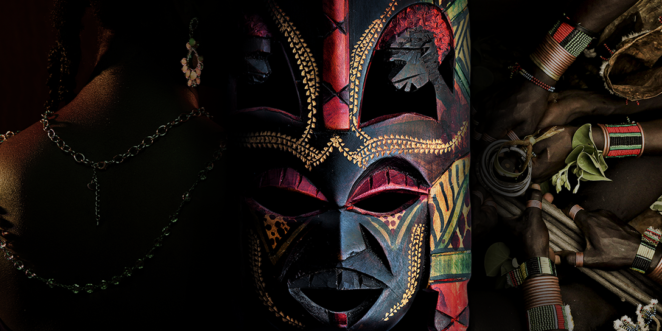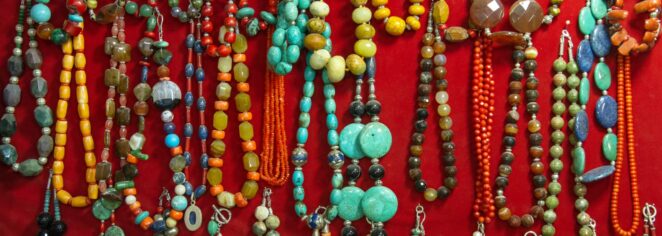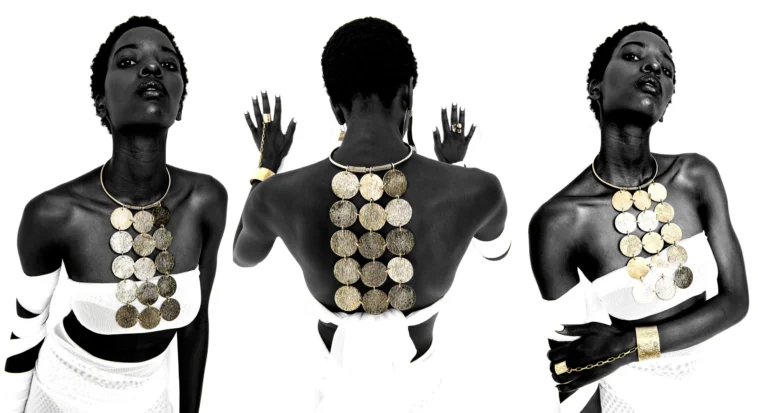Africa, a continent steeped in rich history, diverse cultures, and breathtaking landscapes, has a hidden treasure trove that often sparkles under the sun and moonlight: its jewelry. This intricate and captivating art form carries within it the stories, beliefs, and artistic expressions of countless communities. From the bustling markets of Marrakech to the serene villages of the Maasai, African jewelry reflects the essence of the continent’s people and traditions.
Cultural Significance and Symbolism

African jewelry is far more than just ornamental finery; it encapsulates the profound symbolism ingrained within each culture. Take, for instance, the ubiquitous use of beads. Among the Zulu people, beadwork serves as a language. Each bead color, shape, and pattern conveys messages about marital status, social hierarchy, and even emotional states. In West Africa, gold isn’t merely a precious metal; it embodies spirituality and prestige, often featured in intricate filigree designs. The jewelry worn by various African communities carries the weight of history, connecting wearers to their roots and serving as a tangible link to their ancestors. From the Tuareg’s distinctive silver crosses symbolizing protection to the intricate coral and brass jewelry of the Edo people, African jewelry communicates stories that stretch back generations, fostering a deep sense of cultural identity.
Traditional Materials and Techniques
The crafting of African jewelry for women is an art passed down through generations, utilizing an array of traditional materials and techniques that are as diverse as the continent itself. In Mali, the ancient lost-wax casting technique enables artisans to create astonishingly intricate bronze pieces that adorn both men and women. Cowrie shells, once used as currency and now prized for their aesthetic value, are sewn onto garments by the Yoruba as a sign of wealth and protection. The Maasai, renowned for their vibrant beadwork, meticulously handcraft each piece, incorporating vivid colors to symbolize various aspects of life, from bravery to fertility. By employing methods such as filigree, granulation, and repoussé, African artisans infuse each piece with a distinctive character that stands as a testament to their mastery over age-old techniques.
Regional Styles and Variations
Spanning a continent as vast and diverse as Africa, it’s no surprise that jewelry styles and designs vary widely from region to region. In North Africa, the intricate silverwork of the Tuareg stands in stark contrast to the bold, colorful beadwork of East African communities. The Fulani people, known for their elaborate earrings and headdresses, expertly manipulate gold into delicate filigree patterns. Moving further south, the San people of the Kalahari Desert craft jewelry from ostrich eggshells, bones, and leather, their pieces reflecting the simplicity and harmony of their nomadic lifestyle. The blend of materials, colors, and techniques across different African regions not only speaks to the artistic prowess of local craftsmen but also highlights the incredible cultural diversity woven into the continent’s very fabric.
Historical Evolution

Delving into the historical evolution of African jewelry unveils a timeline rich with cultural exchanges, external influences, and indigenous ingenuity. Ancient Egypt, often regarded as the cradle of civilization, left behind a legacy of remarkable jewelry-making skills, as evident in the intricate amulets and gold burial masks. The trans-Saharan trade routes brought Islamic influences to West Africa, introducing delicate metalwork and enameling techniques that fused with local traditions to create a unique synthesis. Colonialism, while disruptive, also led to the exchange of artistic ideas, as European styles intertwined with African craftsmanship. Over time, these influences melded, giving rise to distinctive hybrid styles such as the Swahili influences of the East African coast. As Africa’s history unfolded, so did the evolution of its jewelry, each piece telling a story of adaptation, resilience, and innovation.
Adornments in Rituals and Ceremonies
Jewelry in Africa transcends mere decoration, playing an integral role in rituals and ceremonies that mark life’s significant milestones. In many communities, jewelry is worn not only to adorn the body but also to invoke blessings, protect against evil spirits, and ensure a smooth passage into the afterlife. During initiation ceremonies, the Dogon people of Mali, for instance, bestow intricate iron and copper creations upon young individuals, signifying their transition into adulthood and their spiritual connection to the cosmos. The Ashanti people’s regal gold jewelry, worn by kings and queens, serves as a visual proclamation of their power and authority. Marriage ceremonies often see the exchange between families, symbolizing unity and the merging of two lineages. These age-old practices demonstrate the enduring significance of jewelry in African societies, where each piece becomes a conduit for cultural values and beliefs.
Contemporary Interpretations and Innovations

While rooted in tradition, African jewelry has also witnessed innovative transformations, with contemporary designers blending ancestral techniques with modern aesthetics. The brand AAKS, founded by Akosua Afriyie-Kumi, rejuvenates traditional Ghanaian weaving methods, resulting in vibrant raffia bags and jewelry that celebrate the country’s heritage. Yameru Kwaito, a South African jewelry line, repurposes discarded materials into striking pieces, exemplifying a commitment to sustainability. Young designers across the continent are infusing their creations with a fresh perspective, bridging the gap between past and present. These adaptations not only breathe new life into ancestral crafts but also serve as a reminder that African jewelry continues to evolve, reflecting the pulse of contemporary culture.
Famous African Designers
The realm of African jewel-making has birthed remarkable designers whose innovative creations have garnered global recognition. One such luminary is Nigeria’s Amadou Diallo, whose brand, Ni’ike, fuses modern elegance with traditional Fulani aesthetics. South African artist Katherine Mary Pichulik draws inspiration from her surroundings, crafting bold statement pieces that resonate with women worldwide. The ethereal pieces of Kenya’s Adele Dejak blend recycled materials with expert craftsmanship, resulting in pieces that mirror the diverse landscapes of Africa. These designers not only shine a spotlight on African jewelry but also underscore the continent’s influence on the global fashion stage, proving that it is more than a local art—it’s a universal language of creativity.
Final Words
African jewelry is an embodiment of Africa itself—complex, diverse, and vibrant. Through the lens of jewel-making, we glimpse the soul of each community, the echoes of history, and the innovative spirit that continues to shape the continent’s artistic landscape. From the scorching Sahara to the lush jungles of the Congo, every piece tells a story, and every design holds a secret. As we celebrate the cultural mosaic, let us recognize its power to transcend time and space, uniting us with the profound beauty and wisdom of a continent rich in jewels and heritage.



